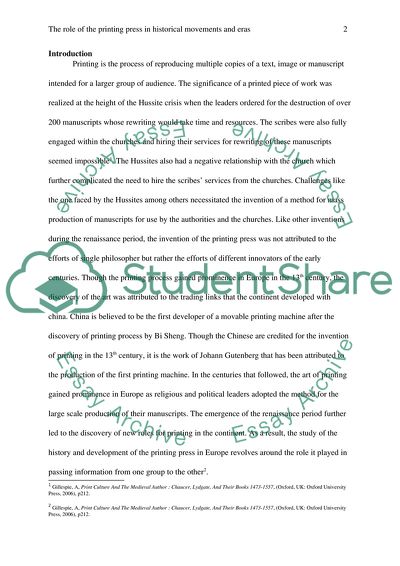Cite this document
(The Role of the Printing Press in Historical Movements and Eras Essay Example | Topics and Well Written Essays - 4000 words, n.d.)
The Role of the Printing Press in Historical Movements and Eras Essay Example | Topics and Well Written Essays - 4000 words. https://studentshare.org/history/1829281-discuss-the-historical-impact-the-printing-press-had-on-european-society-using-elizabeth-eisensteins-the-printing-press-as-an-agent-of-change-communications-and-cultural-transformations-in-early-modern-europe-as-a-primary-text
The Role of the Printing Press in Historical Movements and Eras Essay Example | Topics and Well Written Essays - 4000 words. https://studentshare.org/history/1829281-discuss-the-historical-impact-the-printing-press-had-on-european-society-using-elizabeth-eisensteins-the-printing-press-as-an-agent-of-change-communications-and-cultural-transformations-in-early-modern-europe-as-a-primary-text
(The Role of the Printing Press in Historical Movements and Eras Essay Example | Topics and Well Written Essays - 4000 Words)
The Role of the Printing Press in Historical Movements and Eras Essay Example | Topics and Well Written Essays - 4000 Words. https://studentshare.org/history/1829281-discuss-the-historical-impact-the-printing-press-had-on-european-society-using-elizabeth-eisensteins-the-printing-press-as-an-agent-of-change-communications-and-cultural-transformations-in-early-modern-europe-as-a-primary-text.
The Role of the Printing Press in Historical Movements and Eras Essay Example | Topics and Well Written Essays - 4000 Words. https://studentshare.org/history/1829281-discuss-the-historical-impact-the-printing-press-had-on-european-society-using-elizabeth-eisensteins-the-printing-press-as-an-agent-of-change-communications-and-cultural-transformations-in-early-modern-europe-as-a-primary-text.
“The Role of the Printing Press in Historical Movements and Eras Essay Example | Topics and Well Written Essays - 4000 Words”. https://studentshare.org/history/1829281-discuss-the-historical-impact-the-printing-press-had-on-european-society-using-elizabeth-eisensteins-the-printing-press-as-an-agent-of-change-communications-and-cultural-transformations-in-early-modern-europe-as-a-primary-text.


